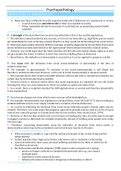Summary
AQA a level psychology- psychopathology summary notes
Detailed Revision Notes of the Psychopathology topic of AQA A-Level Psychology produced by me using both the textbook and class notes. Has both the AO1 and AO3 needed to gain top marks. Includes: DEFINITIONS OF ABNORMALITY, PHOBIAS, BEHAVIOURIST EXPLANATION FOR PHOBIAS, BEHAVIOURIST TREATMENT FOR ...
[Show more]













